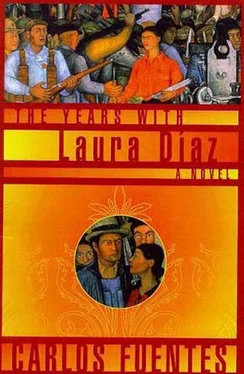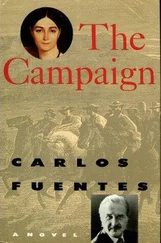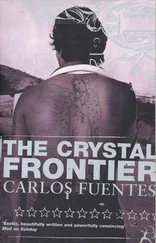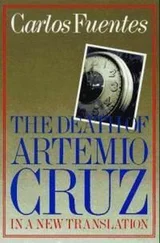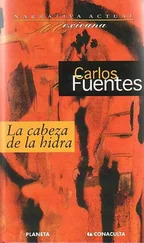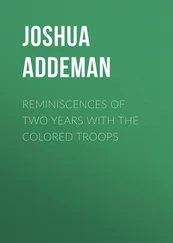Carlos Fuentes
The Years With Laura Diaz
I dedicate this book of my ancestry to my descendants
My children
Cecilia
Carlos
Natasha
IKNEW THE STORY. What I didn’t know was the truth. In a way, my very presence was a lie. I came to Detroit to begin a television documentary on the Mexican muralists in the United States. Secretly, I was more interested in capturing the decay of a great city — the first capital of the automobile, no less, the place where Henry Ford inaugurated mass production of the machine that governs our lives more than any government.
One proof of the city’s power, we’re told, is that in 1932 it invited the Mexican artist Diego Rivera to decorate the walls of the Detroit Institute of Arts. And now, in 1999, I was here — officially, of course — to make a TV series on this and other Mexican murals in the United States. I would begin with Rivera in Detroit, then move on to Orozco at Dartmouth and in California, and then to a mysterious Siqueiros in Los Angeles, which I was instructed to find, as well as lost works by Rivera himself: the mural in Rockefeller Center, obliterated because Lenin and Marx appeared in it; and other large panels which had also disappeared.
This was the job I was assigned. I insisted on beginning in Detroit for one reason. I wanted to photograph the ruin of a great industrial center as a worthy epitaph for our terrible twentieth century. I wasn’t moved either by the moral in the warning or by any apocalyptic taste for misery and deformity, not even by simple humanitarianism. I’m a photographer, but I’m neither the marvelous Sebastião Salgado nor the fearsome Diane Arbus. I’d prefer, if I were a painter, the problem-free clarity of an Ingres or the interior torture of a Bacon. I tried painting. I failed. I got nothing out of it. I told myself that the camera is the paintbrush of our age, so here I am, contracted to do one thing but present — with a presentiment, maybe — to do something else very different.
I got up early to take care of my business before the film team set up in front of Diego’s murals. It was 6 a.m. in the month of February. I expected darkness. I was ready for it. But its duration sapped my energy.
“If you want to do some shopping, if you want to go to a movie, the hotel limo can take you and pick you up,” they told me at the reception desk.
“But the center of town is only two blocks from here,” I answered, both surprised and annoyed.
“Then we can’t take any responsibility.” The receptionist gave me a practiced smile. His face wasn’t memorable.
If the guy only knew that I was going farther, much farther, than the center of town. Though I didn’t know it yet, I was going to reach the heart of this hell of desolation. Walking quickly, I left behind the cluster of skyscrapers arranged like a constellation of mirrors — a new medieval city protected against the attacks of barbarians — and it took me only ten or twelve blocks to get lost in a dark, burned-out wasteland of vacant lots pocked with scabs of garbage.
With each step I took — blindly, because it was still dark, because the only eye I had was my camera, because I was a modern Polyphemus with my right eye glued to the Leica’s viewfinder and my left eye closed, blind, with my left hand extended forward like a police dog, groping, tripping sometimes, other times sinking into something I could smell but not see — I was penetrating into a night that was not only persisting but being reborn. In Detroit, night was born from night.
I let the camera drop onto my chest for an instant, I felt the dull blow over my diaphragm — two diaphragms, mine and the Leica’s — and the sensation was repeated. What surrounded me was not the prolonged night of a winter dawn; it wasn’t, as my imagination would have me believe, a nascent darkness, disturbed companion of the day.
It was permanent darkness, the unexpected darkness of the city, its companion, its faithful mirror. All I had to do was turn right around and see myself in the center of a flat, gray lot, adorned here and there with puddles, fugitive paths traced by fearful feet, naked trees blacker than this landscape after a battle. In the distance, I could see spectral, broken-down Victorian houses with sagging roofs, crumbling chimneys, empty windows, bare porches, dilapidated doors, and, from time to time, the tender and immodest approach of a leafless tree to a grimy skylight. A rocking chair rocked, all by itself, creaking, reminding me, vaguely, of other times barely sensed in memory …
Fields of solitude, withered hill , my schoolboy memory repeated while my hands picked up my camera and my mental hand went from snap to snap, photographing Mexico City, Buenos Aires if it weren’t for the river, Rio if it weren’t for the sea, Caracas if it weren’t a shithole, Lima the horrible, Santa Fe de Bogotá losing its faith, holy or otherwise, Santiago with no saint to cure it. I was photographing the future of our Latin American cities in the present of the most industrial city of all, capital of the automobile, cradle of mass production and the minimum wage: Detroit, Michigan. I made my way shooting all of it, old, abandoned jalopies in lots even more abandoned, sudden streets paved with broken glass, blinking lights in shops selling … selling what?
What could they be selling on the only illuminated corners in this immense black hole? I walked in, almost dazzled by the light, to buy a soda at one of those stands.
A couple almost as ashen as the day stared at me with a mix of mockery, resignation, and malign hospitality, asking me, What do you want? and answering me, We’ve got everything.
I was a little dazed, or it might have been habit, but I ordered, in Spanish, a Coke. They laughed idiotically.
“Stands like this, we only sell beer and wine,” said the man. “No drugs.”
“But lottery tickets we do sell,” added the woman.
I got back to the hotel by instinct, changed my shoes, which were dripping all the waste of oblivion, and was just about to take my second shower of the day when I checked my watch. The crew would be waiting for me in the lobby, and my punctuality signaled not only my prestige but also my discipline. Slipping on my jacket, I looked out at the landscape from the window. A Christian city and an Islamic city coexisted in Detroit. Light illuminated the tops of skyscrapers and mosques. The rest of the world was still sunk in darkness.
We, the whole team, reached the Institute of Arts. First we crossed the same unending wasteland, block after block of vacant lots, here and there the ruin of a Victorian mansion, and at the end of the urban desert (actually right in its heart) a structure in kitschy pompier style from the early years of the century, clean and well preserved, spacious and accessible by means of wide stone stairways and tall doors of steel and glass. It was like a memento of happiness in a trunkful of misfortunes, an old lady, erect and bejeweled, who has outlived her descendants, a Rachel without tears. The Detroit Institute of Arts.
The enormous central courtyard, protected by a high skylight, was the setting for a flower show. It was there the crowds were gathering that morning. Where’d they get the flowers? I asked a gringo in our team; he answered by shrugging his shoulders and not even glancing at the plethora of tulips, chrysanthemums, lilies, and gladiolas displayed on the four sides of the patio — which we crossed with a speed that both the team and I imposed on ourselves. Television and movies are the kind of work you want to get away from fast, as soon as quitting time comes. Unfortunately, those who live on such work can imagine nothing else to do with their lives but to go on filming one day after another after another … we’re here to work.
Читать дальше
